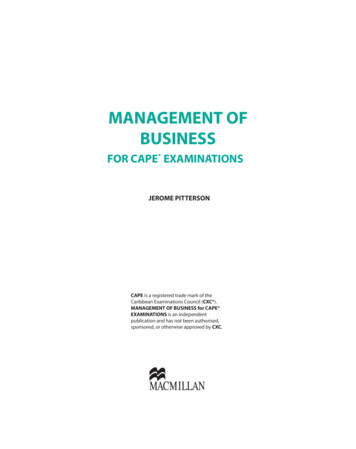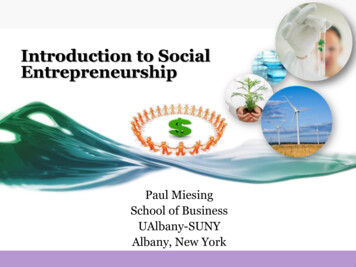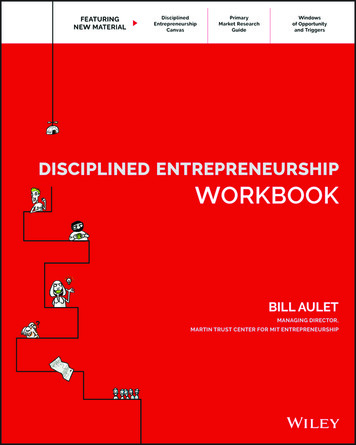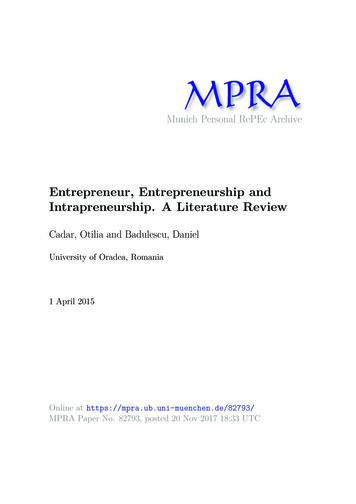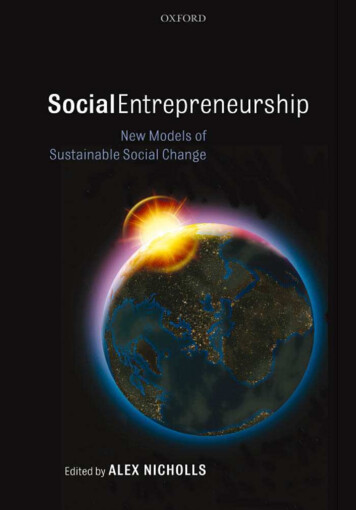
Transcription
SOCIAL ENTREPRENEURSHIP
This page intentionally left blank
SOCIALENTREPRENEURSHIPNew Models of SustainableSocial ChangeEdited byAlex Nicholls1
3Great Clarendon Street, Oxford ox2 6dpOxford University Press is a department of the University of Oxford.It furthers the University’s objective of excellence in research, scholarship,and education by publishing worldwide inOxford New YorkAuckland Cape Town Dar es Salaam Hong Kong KarachiKuala Lumpur Madrid Melbourne Mexico City NairobiNew Delhi Shanghai Taipei TorontoWith offices inArgentina Austria Brazil Chile Czech Republic France GreeceGuatemala Hungary Italy Japan Poland PortugalSingapore South Korea Switzerland Thailand Turkey Ukraine VietnamOxford is a registered trade mark of Oxford University Pressin the UK and in certain other countriesPublished in the United Statesby Oxford University Press Inc., New Yorkß Oxford University Press 2006The moral rights of the authors have been assertedDatabase right Oxford University Press (maker)First published 2006All rights reserved. No part of this publication may be reproduced,stored in a retrieval system, or transmitted, in any form or by any means,without the prior permission in writing of Oxford University Press,or as expressly permitted by law, or under terms agreed with the appropriatereprographics rights organization. Enquiries concerning reproductionoutside the scope of the above should be sent to the Rights Department,Oxford University Press, at the address aboveYou must not circulate this book in any other binding or coverand you must impose this same condition on any acquirerA catalogue record for this title is available from the British LibraryLibrary of Congress Cataloging in Publication DataData availableTypeset by SPI Publisher Services, Pondicherry, IndiaPrinted in Great Britainon acid-free paper byBiddles Ltd., King’s Lynn, NorforkISBN 0–19–928387–7 978–0–19–928387–310 9 8 7 6 5 4 3 2 1
PrefaceJeff SkollThe rapid industrial and technological advancements of the last century haveled to many breakthroughs, but they have also left us to confront an uncertainfuture. With real threats of environmental and economic collapse, terriblediseases, over-population, war, terrorism and menacing new forms of weaponry, we have much to overcome. Efforts by our governments and institutionshave proven insufficient to reverse these destructive trends. Our best hope forthe future of humanity lies in the power and effectiveness of socially motivated, highly empowered, individuals to fight for changes in the way we live,think, and behave.Those four sentences perfectly capture the case for social entrepreneurship.But they are not unique to our time: the same could have been said 100 yearsago, 200 years ago, 300 years ago at the beginning of the Industrial Revolution.One of the great ironies of history is that the solutions to current challengesfrequently create new challenges even more menacing. Industries that haveimproved the quality of our lives have also created new problems that threatenour very existence. Technological innovations that were developed to increasethe efficiency of life have frequently been used to increase the efficiency oftaking life. We can split the atom, walk on the moon, communicate withanother person anywhere in the world in the blink of an eye, and yet poverty,violence, and illness in much of the world are as pervasive as they have everbeen.But the nature and the wonder of humanity is that while there are alwaystumultuous events and seemingly overwhelming challenges to face, people,exceptional individuals, and ideas and movements emerge to face and findsolutions to these challenges.Social entrepreneurs are those people—the practical dreamers who have thetalent and the skill and the vision to solve the problems, to change the worldfor the better. Social entrepreneurs have a unique approach that is bothevolutionary and revolutionary, operating in a free market where success ismeasured not just in financial profit but also in the improvement of thequality of people’s lives. Social entrepreneurs take workable value creationmodels and adapt them for the benefit of all our communities. They do notbuy into the notion that only governments and powerful individuals andcorporations are in a position to determine where and how resources areallocated. They believe that any individual has the potential to make positivev
Prefacechanges not just in our communities, but also in society as a whole. And theyput that belief into action, in creative ways that are described throughout thisbook.At the world’s great foundations, universities and charitable institutions,social entrepreneurship has rapidly become the most influential idea of ourtime. For these institutions, theories of social entrepreneurship offers a powerful tool to identify, train and support individuals with the potential to createmajor social change. For the entrepreneurs themselves, it presents a roadmapto realize their dreams.Yet, for all of this, social entrepreneurship remains as much an idea as amovement. There is a great need for ongoing scholarship and publicationsthat serve as a call to arms to current social entrepreneurs, as an inspiration tobudding social entrepreneurs, and to document the field for institutions,academics, and legislators.The Skoll Foundation has supported the Skoll Centre for Social Entrepreneurship to contribute to meeting this need, and to promote the advancementof social entrepreneurship worldwide. This volume, synthesizing research andlessons from practice by leading social entrepreneurs and scholars in the fieldwho gathered for the first Skoll World Forum on Social Entrepreneurship inMarch 2004, exemplifies the Centre’s aim to produce work that both engageswith theory and is also valuable to practitioners in the field.Social entrepreneurs have a vision of the future and will stop at nothing tosee that future come true. It is up to us to help them succeed in order to ensurethat the failures of the past do not become the failures of the future, and tobuild a world where all people, regardless of geography, background, or economic status, enjoy and employ the full range of their talents and abilities.vi
ContentsAcknowledgementsxList of FiguresxiList of TablesxivAbbreviationsxvAbout the AuthorsIntroductionAlex Nichollsxix1Part I. New Perspectives371. Social Business Entrepreneurs Are the SolutionMuhammad Yunus392. The Citizen Sector TransformedBill Drayton453. For What It Is Worth: Social Value and the Future of SocialEntrepreneurshipRowena Young4. Cultivating the Other Invisible Hand of SocialEntrepreneurship: Comparative Advantage, Public Policy,and Future Research PrioritiesGeoff Mulgan5674Part II. New Theories975. Social Entrepreneurship: The Structuration of a FieldAlex Nicholls and Albert Hyunbae Cho996. Social Entrepreneurship: Agency in a Globalizing WorldPaola Grenier119vii
Contents7. Rhetoric, Reality, and Research: Building a Solid Foundation forthe Practice of Social EntrepreneurshipBeth Battle Anderson and J. Gregory Dees8. Social Entrepreneurship: It Is for Corporations, TooJames E. Austin, Herman B. Leonard, Ezequiel Reficco,and Jane Wei-Skillern9. Social Entrepreneurship: Exploring a Cultural Mode AmidstOthers in the Church of EnglandDoug Foster144169181Part III. New Models20310. Social Enterprise Models and Their Mission and MoneyRelationshipsSutia Kim Alter20511. The Socially Entrepreneurial CityCharles Leadbeater23312. Helping People Is Difficult: Growth and Performance in SocialEnterprises Working for International Relief and DevelopmentAlex Jacobs24713. The Social Entrepreneurship Collaboratory (SE Lab): A UniversityIncubator for a Rising Generation of Social EntrepreneursGordon M. Bloom270Part IV. New Directions30714. Wayfinding Without a Compass: Philanthropy’s ChangingLandscape and Its Implications for Social EntrepreneursSally Osberg30915. Delivering on the Promise of Social Entrepreneurship:Challenges Faced in Launching a Global Social Capital MarketPamela Hartigan32916. Social Entrepreneurship: The Promise and the PerilsJerr Boschee17. Moving Ahead Together: Implications of a Blended ValueFramework for the Future of Social EntrepreneurshipJed Emersonviii356391
ContentsEndnoteAlex Nicholls407Bibliography413Index431ix
AcknowledgementsFirst, I should like to thank all the outstanding contributors to this collectionwho so generously gave their time, thinking, and research. Their patience withme throughout the—sometimes tortuous—process of editing this historicvolume has been exemplary and is much appreciated.Second, I owe a considerable debt of gratitude to my academic ‘patrons’—Jeff Skoll and Prof. Anthony Hopwood—without whose material support thisbook could never have been written.Third, I want to single out for thanks my mother Catherine Nicholls, whohas been tireless and fearless in her support of my work over the years. She istruly an extraordinary woman. Sam and Harriet have also been vital to me asthis book has come together and are always in my thoughts.I want to praise the Skoll Centre for Social Entrepreneurship support team—Kathryn Smyth and Mona Turnbull—for their good humour and skill whilstmaking considerable contributions to the Skoll World Forum in Social Entrepreneurship and the running of the Centre in general. Finally, I also need toexpress my most affectionate thanks to my extraordinary colleague at the SkollCentre, Rowena Young, who helped me frame my arguments and structure thebook throughout its production.This book is dedicated to Isabel, my guiding star.‘Social Entrepreneurs need always to be ten years ahead of their time and to be preparedto be ridiculed. This is the only way to bring about real change.’Bunker Roy, Barefoot College (Campinas, Brazil, 2004)x
List of FiguresI.1. Positioning of social entrepreneurship internationallyI.2. Funding dimensions of social entrepreneurship2.1. The same historical forces are at work even in the Germanheart of Europe512485.1. Dimensions of Social Entrepreneurship1037.1. A perspective on financial strategies: Dependency vs.self-sufficiency1468.1. Changing expectations: Should large companies be heldresponsible for helping solve social problems like crime,poverty, and lack of education?1718.2. Changing expectations: Should large companies be heldresponsible for improving education and skills in communitieswhere they operate?1728.3. Changing expectations: Should large companies be heldresponsible for ensuring that its supplies have been producedin a socially and environmentally responsible manner?1728.4. Ignore at your own peril: In the past year, have youconsidered punishing a company you see as not socially?1738.5. Ignore at your own peril1738.6. Buying preferences: I would be likely to switch brands to oneassociated with a good cause, if price and quality are similar1748.7. Price premium: ‘I would pay 10 per cent more for a productthat was produced in a socially and environmentallyresponsible way. . . ’1748.8. Competitive advantage: ‘A company’s commitment to socialissues is important when I decide . . . ’1758.9. Motivational spectrum17510.1. Social enterprise type by mission orientation20910.2. Embedded social enterprise21210.3. Integrated social enterprise21310.4. External social enterprise213xi
List of Figures10.5.Legend for figures21410.6.Entrepreneur support model21510.7.Market intermediary model21710.8.Employment model21810.9.Fee-for-service model21910.10. Service subsidization model22110.11. Market linkage model22210.12. Organizational support model22410.13. Complex model22610.14. Mixed model22610.15. Franchise model22810.16. Private-not-for-profit model22913.1.Key characteristics of the SE Lab27313.2.Defining social entrepreneurship27913.3.Sources of social entrepreneurship28013.4.The Social Enterprise Spectrum28013.5.Sudan child28213.6.The Vision Framework28313.7.The Opportunity Creation Process28413.8.Value, Capacity, Support Framework derived fromthe Strategic Triangle286Six-force chart for nonprofit industry analysis28713.9.13.10. The Basic Logic Model28813.11. The Performance Management Framework29013.12. Intended impact and theory of change29013.13. Selected teaching tools of the social entrepreneurshipcollaboratory29213.14. Selected guest lecturers in the SE Lab29614.1.The rise in US not-for profits vs. grant making foundations31314.2.Three points of orientation for market-conscious,knowledge-driven philanthropists31614.3.Traditional vs. market-based grant giving31715.1.Accreditation considers three main aspects33315.2.Management and monitoring: The organizationmanages selected initiatives according to its qualitystandards and mission337xii
List of Figures15.3.15.4.Organizational set-up: The organization has a cleargovernance structure fostering its mission, institutionalstrengths, and accountability338Building a social infrastructure of entrepreneurshipand innovation34616.1.The Organized Abandonment Grid36416.2.Crossing the cultural divide37117.1.Blended Value39217.2.The Blended Value process403xiii
List of TablesI.1. Drivers behind the growth of social entrepreneurship2I.2. University centres for social entrepreneurship8I.3. Universities (without a dedicated social entrepreneurshipcentre) offering research and/or teaching in socialentrepreneurship9I.4. Network support organizations for social entrepreneurs10I.5. Defining the ‘social’ in social entrepreneurship14I.6. Social market failures addressed by social entrepreneurs165.1. Relationship between organizational isomorphism andlegitimacy1139.1. Examples of parish profile variation within ‘Seagull diocese’187xiv
AbbreviationsList of AbbreviationsAIMSAid Information Mapping ServicesALMOArm’s-Length Management OrganizationALNAPActive Learning Network for Accountability and PracticeALPSAccountability, Learning, and Planning SystemAMAAmerican Medical AssociationANCAAssociacao Nacional de Cooperacao AgricolaBRACBangladesh Rural Advancement CommitteeCAFCharities Aid FoundationCEPCenter for Effective PhilanthropyCFOChief Finance OfficerCICCommunity Interest CompanyCNFACitizens Network for Foreign AffairsCOOChief Operating OfficeCSECorporate Social EntrepreneurshipCSICenter for Social Innovation (Stanford)CSRCorporate social responsibilityDdGDiálogo de GestionesDfIDDepartment for International DevelopmentDTIDepartment for Trade and IndustryEUEuropean UnionFUSIONFuture Social Innovators Network (Stanford)GSBGraduate School of Business (Stanford)GDPGross Domestic ProductGEMGlobal Entrepreneurship MonitorGEXSIGlobal Exchange for Social InvestmentGMAGlobal Micro-Entrepreneurship AwardsGTZGerman Development Agencyxv
AbbreviationsHBSHarvard Business SchoolICGInternational Crisis GroupIEAInstitute for Economic AffairsINGOInternational Non-Governmental OrganizationIOWHInstitute for One World HealthIPPInstitute of Public PolicyISERCInternational Social Entrepreneurship ConferenceKSGKennedy School of Government (Harvard)LLCsLimited Liability CorporationsLPsLimited PartnershipsMISManagement Information SystemsMITMassachusetts Institute of TechnologyMNCMultinational CorporationMS&EManagement Science and Engineering (Stanford)NEPADNew Partnership for Africa’s DevelopmentNESsTNon-Profit Enterprise and Self-Sustainability TeamNFFNonprofit Finance FundNGOsNon-Governmental OrganizationsNHSNational Health ServiceNPOsNot-For-Profit OrganizationsNPVNet Present ValueODIOverseas Development InstituteOEDOxford English DictionaryPMPPublic Management Program (Stanford)RISEResearch Initiative in Social EntrepreneurshipROIReturn on InvestmentSAMOPNSouthern African Marula Oil Producers NetworkSE LabSocial Entrepreneurship Collaboratory (Stanford, Harvard)SEKNSocial Enterprise Knowledge NetworkSEPSocial Entrepreneurship ProgrammeSIISStanford Institute for International StudiesSocial E-ChallengeSocial Entrepreneurs Challenge (Stanford)SROISocial Return on InvestmentUKUnited KingdomUPAsUrban Priority AreasUSAUnited States of Americaxvi
AbbreviationsVESCVirginia Eastern Shore CorporationWEFWorld Economic ForumA Note on Currency ConversionsThis book includes figures in US dollars ( ) and UK pounds ( ). The exchangerates calculations used are correct at the time of going to press (December2005) and are as follows:CurrencyConversion rateEuro1 1.18Euro1 0.69 1 0.58 1 1.72A Note on the Meaning of ‘Not-for-Profit’There appears to be a degree of substitution of the terms ‘nonprofit’ and ‘notfor-profit’ across international scholarship. Both are used to describe socialpurpose ventures that often—but not always—have special tax advantages.However, there is some confusion over whether these terms describe thestrategic function of the organization (i.e. that its mission is not to make aprofit) or the process of what it actually does (i.e. its activities are not profitable). There is a further complexity in that both terms can be extended at timesto the sense of ‘profitable, but not profit distributing’ (i.e. without externalshareholders). Indeed, in the USA, legally a nonprofit organization is one thatdoes not declare a profit and instead utilizes all revenue available after normaloperating expenses in service to the public interest. This sense may be appliedparticularly to successful social enterprises, but also allows large corporationssuch as the John Lewis Partnership (which is owned by its workforce) to betechnically classed as ‘nonprofits’, even though such a large and profitableorganization would not be typically thought of by many as a not-for-profit.Nonprofit is typically used in the USA to describe social purpose organizations that serve the public interest and are registered as 501(c)(3) tax-exemptorganizations. These would often be recognized as charities in the UK. Not-forprofit is used more commonly in the UK for a range of social purpose organizations including charities, co-operatives, and voluntary organizations.It is also possible to include under this heading a distinct category of socialenterprises that uses equity, or equity-like, finance and which may distributexvii
Abbreviationssome profits, but is mission driven and not set up for private gain. In such casesequity will have been offered as a strategy for accessing new finance and will bemade available under terms that cannot jeopardize the ‘social’ or communityownership of the venture. In 2005, the UK government acknowledged thisinnovative type of social enterprise by introducing a new legal form for suchorganizations—the Community Interest Company (CIC). The CIC features an‘asset lock’ and limits the amount of dividend distribution to encourage awider range of finance into social ventures without risking mission drift.To achieve clarity for the reader of this book, the term not-for-profit is usedexclusively throughout. As used here, the term describes any venture that has,as its prime strategic aim, a social purpose and is either not profit distributingor offers only limited dividends in accord with its social mission, whether it istax paying or not and irrespective of its income mix.xviii
About the AuthorsAlex NichollsDr Nicholls is the first lecturer in social entrepreneurship appointed in the UK.His research and teaching experience fall across a range of subjects centred onsocial and ethical issues. Nicholls has a background in retail marketing and,before that, medieval lexicography, but in recent years has developed particularinterests in Fair Trade, business ethics, and the interface between marketingand society. He has been working in the specific area of social entrepreneurshipfor some time and acted as the external consultant for the establishment of theSkoll Centre for Social Entrepreneurship at the Saı̈d Business School.Nicholls has published in a range of refereed journals, including the European Journal of Marketing and Service Industries Journal, and has presented papersat many international conferences. He has also co-authored a major researchbook Fair Trade: Market Driven Ethical Consumption for Sage Publishers (2005).Nicholls has held lectureships at a wide variety of academic institutionsincluding: the University of Toronto, Canada; Leeds Metropolitan University;University of Surrey; Aston Business School.Nicholls is a fellow of the Academy of Marketing Science and member of theInstitute of Learning and Teaching. He also sits on the regional social enterprise expert group for the South East of England Development Agency.Jeff SkollJeff Skoll served as eBay’s first full-time employee and first president, creating thebusiness plan that the company still follows. In 1998 he inspired the company totake an active role in philanthropy, pioneering creation of the eBay Foundationthrough the allocation of pre-IPO shares. This innovation sparked similar initiatives by other young companies in high-technology hubs across the USA. In1999 Skoll created the Skoll Foundation, which takes an entrepreneurialapproach to philanthropy, seeking out and empowering the world’s most promising social entrepreneurs in order to effect lasting, positive social changeworldwide. Today, he serves as chairman of the Skoll Foundation and continuesto build the foundation, which has tripled in size over the past year.In addition to his role as Skoll Foundation chairman, Skoll directs hisinvestment group, Capricorn Management, and leads a venture in Hollywoodto produce feature films highlighting social entrepreneurs who overcome theinjustice of social inequity. He also serves as a board director for the eBayxix
About the AuthorsFoundation and Community Foundation Silicon Valley and is a member of theadvisory board of the Stanford Graduate School of Business, among others. Heholds a BSc in electrical engineering from the University of Toronto and anMBA from the Stanford Graduate School of Business.His recent honours and awards include Canada’s 1999 Leafy Award for hiscontributions to high technology; a 2001 Visionary Award from the SoftwareDevelopment Forum; the 2002 Outstanding Philanthropist Award from theSilicon Valley chapter of the Association of Fundraising Professionals; the 2003Outstanding Philanthropist Award from the International Association ofFundraising Professionals; and, in 2003, an honorary Doctor of Law degreefrom his alma mater, the University of Toronto. In 2002, Skoll was identified byBusiness Week as one of the most innovative philanthropists of the past decade.Muhammad YunusProfessor Yunus is the founder and managing director of Grameen Bank whichcurrently operates 1,537 branches providing credit to 4.7 million poor peopleresiding in 54,022 villages in Bangladesh. He originated the concept ofGrameen Bank, i.e. banking without collateral for the poorest of the poor.Yunus studied economics at Vanderbilt University, USA and received his Ph.D.in economics in 1970. He taught economics at Middle Tennessee Universityfrom 1969 to 1972. Returning to Bangladesh in 1972, he joined the Universityof Chittagong as Head of the Economics Department. He started the GrameenBank Project in 1976. It was transformed into a formal bank in 1983. TheGrameen Bank offers small loans for self-employment to the rural poor,especially poor women.In addition to Grameen Bank, Yunus has created a number of companies inBangladesh to address diverse issues of poverty and development. Among themare: Grameen Phone (a mobile telephone company); Grameen Cybernet (Internet Service Provider); Grameen Communications (Rural Internet Service Provider); Grameen Software company; Grameen Information Technology Park;Grameen Fund (Social Venture Capital Company); Grameen Capital Management Company; Grameen Textile Company; Grameen Knitwear Company;Grameen Renewable Energy Company; Grameen Health Company; GrameenEducation Company; Grameen Agriculture Company; Grameen Fisheries andLivestock Company; and Grameen Business Promotion Company.Yunus has been widely honoured. Amongst his awards are: Ramon MagsaysayAward (1984) from the Philippines; Aga Khan Award for Architecture (1989)from Switzerland; Mohamed Shabdeen Award for Science, Socio-Economic(1993) from Sri Lanka; World Food Prize (1994) from USA; Simon BolivarPrize (1996) from Venezuela; Man for Peace Award (1997) from Italy; Princeof Austurias Award for Concord (1998) from Spain; Ozaki (Gakudo) Award(1998) from Japan; Indira Gandhi Award (1998) from India; Sydney PeacePrize (1998) from Australia; Rotary Award for World Understanding (1999)xx
About the Authorsfrom USA; Golden Pegasus Award (1999) from Italy; Roma Award for Peace andHumanitarian Action (1999) from Italy; King Hussein Humanitarian LeadershipAward (2000) from Jordan, International Cooperation Prize Caja de Granada(2001) from Spain; ‘NAVARRA’ International Aid Award (2001) from Spain;Grand Prize of the Fukuoka Asian Culture Prize (2001) from Japan; MahatmaGandhi Award (2002) from USA; Volvo Environment Prize (2003) from Sweden;Citta di Orvieto Award (2004) from Italy; Nikkei Asia Prize (2004) from Japan;The Economist Award for Social and Economic Innovation (2004) from USA.Within Bangladesh, he received the President’s Award (1978); Central BankAward (1985); and Independence Day Award (1987), the highest nationalaward. He was the first chair of the Policy Advisory Group of CGAP (ConsultativeGroup to Assist the Poorest). He has been appointed as an International GoodwillAmbassador for UNAIDS by the United Nations. Yunus has also been inducted asa member of the Legion d’Honneur by President Chirac of France.Bill DraytonBill Drayton has been a social entrepreneur since he was a New York Cityelementary school student. He was born to a mother who emigrated fromAustralia as a young cellist and an American father who, also unafraid to stepinto the unknown, became an explorer at an equally young age. Public serviceand strong values run through the stories of both parents’ families—includingseveral of the earliest anti-slavery abolitionist and women’s leaders in the USA.These family influences, the rich diversity and openness of life in Manhattan—as well as America’s deep cultural concern with equity, which flourishedduring the Civil Rights years—all interacted with one another and with Drayton’s temperament to plant Ashoka’s earliest roots. In elementary school,Drayton loved geography and history and was equally unmotivated in Latinand maths. His real passion in those years went to sailing, and starting andrunning a series of newspapers in his school and beyond. In high school hecreated and built the Asia Society into the largest student organization. Byhigh school he was also a NAACP member and actively engaged in and deeplymoved by civil rights work. At Harvard he founded the Ashoka Table; and, atYale Law School, he launched Yale Legislative Services which, by the time hegraduated, engaged one-third of the student body in helping key legislatorsthroughout the northeast design and draft legislation.Drayton’s deepening commitments to Asia, especially South Asia, and tocivil rights were closely linked. Martin Luther King, Jr. followed MahatmaGandhi’s way, and anyone concerned with inequity within the USA couldonly be more disturbed by the greater inequalities between the world’s Northand South. Once focused on such a chasm, any entrepreneur would have toask: ‘What can I do?’. At Harvard and Oxford, Drayton did ask. Fully appreciating how central to significant change (‘development’) entrepreneurs are, hisanswer was the Ashoka idea. Drayton is also a manager and managementxxi
About the Authorsconsultant—choices that also grow from his fascination with how humaninstitutions work. Although he loves and thinks first in historical terms, he istrained in economics, law, and management, the three key-interventionistdisciplines. He was a McKinsey & Company consultant for almost ten years,gaining wide experience serving both public and private clients.For four years, he was assistant administrator at the US EnvironmentalProtection Agency, where he had lead responsibility for policy, budget, management, audit, and representing the environment in Administration-widepolicy development, notably including budget, energy, and economic policy.He successfully ‘intrapreneured’ a series of major innovations and reforms inthe field, ranging from the introduction of emissions trading to the use ofeconomics-defined incentives to remove the advantage of delaying compliance. Later he founded and led Save EPA (an association of professional environmental managers that helped the Congress, press, Administration, citizengroups, and public understand and then block much of the radically destructive policies proposed by the Administrator Ann Gorsuch and others). Draytonalso founded and led Environmental Safety (which helps develop and spreadbetter ways of implementing environmental laws). He also served briefly in theWhite House, and taught both law and management at Stanford Law Schooland Harvard’s Kennedy School of Government. He is currently significantlyinvolved as board chair of Get America Working! and Youth Venture, bothmajor strategic innovations for the public good.Drayton has received many awards for his achievements. He was elected oneof the early MacArthur fellows for his work, including the founding of Ashoka.Yale School of Management gave him its annual Award for EntrepreneurialExcellence. The American Society of Public Administration and the NationalAcademy of Public Administration jointly awarded him their National PublicService Award, and the Common Cause gave him its Public Service Achievement Award. He has also been named a Preiskel-Silverman Fellow for Yale LawSchool and is a member of the American Academy of Arts and Sciences.Rowena YoungRowena Young has been involved in the formation of the social entrepreneurship movement in the UK since its inception in the late 1990s. She is Director ofthe Skoll Centre for Social Entrepreneurship at the Saı̈d Business School. TheCentre was launched in N
book. At the world’s great foundations, universities and charitable institutions, social entrepreneurship has rapidly become the most influential idea of our time. For these institutions, theories of social entrepreneurship offers a power-ful tool to identify, train and support indi
